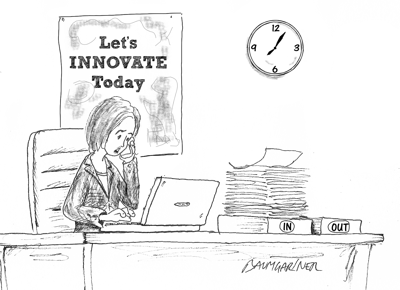
No Time for Innovation? Think Again!
By Jeffrey Baumgartner
Innovation is important to your firm – at least assuming you are a manager in an organisation – is it not? But where does innovation sit on the priority list of your employees? Probably further down that list than you would like. In my experience, in most organisations, people put innovation at the bottom of their list of priorities, below report writing, below answering e-mails, below making presentations, below calculating financials, indeed, below all their day to day routine work.
Time to Innovate
Some years ago, I posted a research report, “Organisational Creativity – the Top Ten Enablers" (PDF) by Wayne Morris. He found that the number one barrier to organisational creativity, and hence innovation, is lack of time. In the report, Wayne wrote: “More respondents raised the issue of time as the most important factor in enhancing organisational creativity than any other with comments such as, 'Just having uninterrupted time would do it for me. It’s so rare that I make space and time in my day to just think. I know that when I do it works really well for me and I get a lot more satisfaction from my work. It remains a real challenge for me.'”
Innovation managers that I work with have also commented on this as a challenge to their initiatives. They say that many colleagues complain that they do not have time for creative thinking or innovation.
It's Not Time, It's Priorities
The truth is, employees have lots of time. In the developed world, most organisations stipulate a 35-40 hour work week. Many people work much longer hours, particularly in the USA. Seven or more hours per working day is actually an awful lot of time for creative thinking and innovative action. Clearly, then, the problem is not really time.
Rather, the problem is that employees believe that being creative is of such little importance, that every other task in their job description should be done first. Thus, even though management states that “Innovation is our number one priority” or "creative employees are critical to our future success", most employees feel that “Putting the financial projections for the third quarter into a nifty spreadsheet in time for tomorrow's division meeting is my number one priority” and innovation probably comes in at around priority number 50, after answering unimportant e-mails, tidying the desk and filing away that massive stack of papers on the desk.
Why Innovation Is a Low Priority for Many
There are several reasons for this. First and foremost, although management says “Innovation is the company's number one priority”, it is not demonstrating to employees that innovation is their number one priority. (Quick definition: corporate innovation = the profitable implementation of creative ideas). Until that is communicated to employees, few will bother with active creative thinking.
This bring us to our second reason. Being creative often does not look like work. My creative juices flow best when I walk. This helps me not only come up with ideas, but it also helps me analyse ideas and make decisions. Others sit in chairs and stare out the window. Some people are best in the bathtub. Unfortunately, none of these activities looks like real work.
If you have an open plan office or even an open-ish office, employees are going to be self-conscious about sitting and thinking. They know it will not look like they are working and they will fear being looked down upon by their neighbouring colleagues. In my employee days, I only ever had one boss who was okay with my taking a walk to think through a problem and even then, colleagues looked askance at my mid-day wanderings.
The third reason is that creativity and innovation are very fuzzy concepts. While most employees are very clear on what is involved in preparing a financial projection, how to respond to a customer query and what information to include in a report, few know just what is involved in being creative and innovative. Thus, for them it is easier to be busy with concrete tasks with clear rules rather than to have to struggle with vague notions of being creative.
Of course, employees generally receive some kind of training on how to complete a financial projection spreadsheet, the company style for internal reports and how to respond to customer queries. Far fewer receive training on how to be creative.
What Organisations Can Do
There are a few things organistions can do to prioritise innovation, though many of these need to come from the top. The very first thing management needs to decide is to decide to what extent creativity and innovation really are priorities. Innovation sounds nice, but it involves taking risks and inviting change, things that are not always so nice. Assuming, however, management decides that innovation is indeed jolly important, here are some things the organisation can and should do.
Firstly, demonstrate that innovation is a priority. A great way to do this is by innovating and talking about it. Share stories about ideas that people have had, how teams developed those ideas and the results. Do not be afraid to share innovative ideas that did not work out, rather explain the idea, what went wrong and why.
Secondly, provide spaces for spontaneous meetings, reflection and creativity. An innovation room full of paper, construction tools, comfortable seating (possibly including huge pillows and beanbag chairs), toys and a great coffee machine provides a great environment for creative thinking.
Thirdly, consider investing in creativity training that gives people tools and techniques for being creative. Investing in training demonstrates that you are serious about it.
Fourthly, recognise and reward creative thinking and innovative action. Rewards need not be massive. Indeed, overly large rewards tend to be counterproductive (as this Youtube video by Daniel Pink explains).
Fifthly, and this is the hardest, organisations should reduce the workload of their employees. Being busy, not having enough time, being available by mobile phone 24-7, stress and burnout are all too common these days and indicate that people are being worked too hard to be creative. In the near future, I believe that corporate leaders may need to decide between running an innovative company in which creativity flourishes or a company in which people are super productive, but have little time to think beyond their next tasks. Perhaps as automation takes over more jobs, visionary leaders will realise it makes more sense to keep people on as creative thinkers, rather than reduce the workforce with the reduced task-based workload.
What do you think?
R103/20160705




